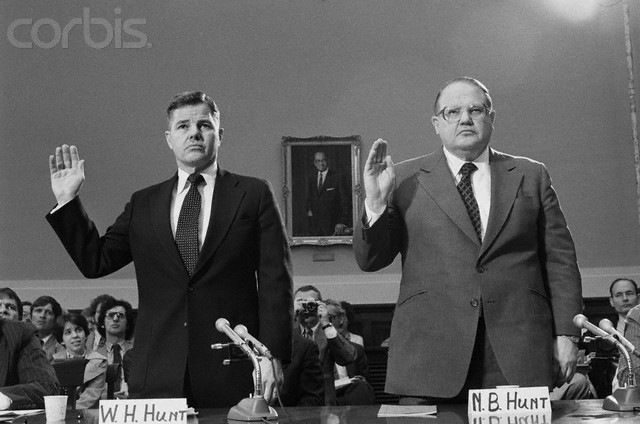The Hunt Brothers and their attempt to Corner the Silver Market Traders Log
Post on: 24 Июнь, 2015 No Comment

Posted By: TradersLog
In the early seventies, amidst political upheaval, inflationary pressures and stagnant economic growth, the richest family in America (at the time), the Hunt family of Texas, tried to corner the market on precious metals. As a way to hedge themselves from the rampart printing of dollars the US government was doing, the Hunts decided to accumulate large amounts of hard asset investments. Since gold could not be held by private citizens back then, the Hunt brothers focused on silver.
In 1979, the Hunt brothers, along with a group of wealthy Arabs, formed a pool buying silver and silver futures. The Hunt brothers used their positions in silver futures to acquire more of the physical metal. As cash was continually losing value due to inflation, the Hunts decided to settle their long silver futures contracts with delivery of silver, instead of cash settlement. Before too long, they had amassed over 200 million ounces of silver which was about half of the world’s supply.
Prices soon started to appreciate. When they started, the price of silver was below $5 ounce. By late 1979/early 1980 prices had increased tenfold and were trading near $55/oz. During this rise in prices, the COMEX and Chicago Board of Trade (CBOT) only had about 120 million ounces of silver between them. As prices went higher and new buyers got into the market, the exchanges became increasingly fearful of defaulting. As the Hunts owned 77% of the world’s silver, either in physical form or futures contracts, the market had been cornered.
Things began to change once Paul Volker was named Chairman of the Federal Reserve. Volker was determined to get inflation under control by raising interest rates. Couple that with changes in trading rules at the CBOT and COMEX, prices soon plummeted. Things had gotten so out of whack that COMEX only accepted liquidation orders, effectively halting silver from going higher. The CBOT set limits on the amount of silver any one entity could hold and raised margins. Not surprisingly prices came down significantly quickly and were trading near $10 by the end of March 1980.
The precipitous drop in prices meant huge losses for many speculators and ultimately forced the Hunt brothers into bankruptcy. By the mid-80s, the Hunt brothers had more than a billion dollars in liabilities they could not meet. At their peak, the Hunt brothers had held over $4.5 billion in silver on their $1 billon investment. On March 25, 1980, the Hunt brothers couldn’t meet their $135 million margin call, forcing the Hunt brothers to ‘shut it down.’ In August of 1988, the Hunts were convicted of conspiring to manipulate the market.

It was in late March 1980 that we had “Silver Thursday”, a day where the price of silver went from roughly $20/oz to $10/oz, a loss of over 50%. Ultimately, the Hunts had to be bailed out by New York banks so they could make good on their obligations. Their obligations had grown so large that the government forced the banks to issue credit so that wide spread failures could be prevented.
The Hunts had exposed themselves to huge amounts of leverage, which worked great in the beginning. It was this leverage from the futures markets that ultimately did them in. The Hunts ended up losing because they couldn’t fight the Fed and the system as a whole. The exchanges changed the rules once they saw they were out maneuvered and couldn’t default, which would have led to widespread failures. Not only that, but many of the regulators who helped change the rules were also short silver.
In the end, cornering a market is not only illegal but immoral as well. In a truly free market, cornering a market wouldn’t work as alternative investments would gain favor. Also, as supply is taken off the market, buying the last bit of any commodity would become prohibitively expensive. If the Hunts had only bought physical silver, there was nothing that financial industry or the government could have done. Conversely, if they only bought physical silver, the market probably wouldn’t have gone up that much, but they never would have had any futures contracts obligations to meet. Today, the price of silver is finally close to testing the artificial highs of the early 80s. Similar to the late 70s, inflation is spreading, political situations around the globe are precarious at best and energy prices are near highs. Position limits and daily marked to the market accounting, makes it nearly impossible to corner any market today. In the end, the Hunts tried to fight financial industry insiders and the US government, only to have the rules of the game changed in the middle of the game. But don’t feel too bad for them, although they lost huge amounts of money, they still are worth several hundreds of millions of dollars, each.














